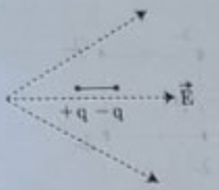Along the axis of a dipole, direction of electric field is always in the direction of electric dipole moment p. Is this statement true of false?
To determine whether the statement "Along the axis of a dipole, the direction of the electric field is always in the direction of the electric dipole moment p" is true or false, we can analyze the concepts of electric dipole moment and electric field.
1. Understanding Electric Dipole Moment (p):
- The electric dipole moment p is defined as the product of the charge q and the distance d between the two charges. It is a vector quantity that points from the negative charge to the positive charge.
- Mathematically, p=q⋅d, where d is the vector pointing from the negative charge to the positive charge.
2. Electric Field Due to a Dipole:
- The electric field E due to an electric dipole at a point along its axial line (the line extending from the positive charge to the negative charge) can be derived from the dipole's configuration.
- The electric field along the axis of the dipole is directed away from the positive charge and towards the negative charge.
3. Direction of Electric Field:
- On the axial line, the electric field E points in the same direction as the dipole moment p when considering points beyond the dipole (i.e., far from the dipole).
- Therefore, at points along the axis of the dipole, the electric field indeed points in the direction of the dipole moment.
4. Conclusion:
- Since the electric field along the axis of the dipole is directed in the same direction as the dipole moment p, the statement is True.
Final Answer:
The statement is True.
- The electric dipole moment p is defined as the product of the charge q and the distance d between the two charges. It is a vector quantity that points from the negative charge to the positive charge.
- Mathematically, p=q⋅d, where d is the vector pointing from the negative charge to the positive charge.
- The electric field E due to an electric dipole at a point along its axial line (the line extending from the positive charge to the negative charge) can be derived from the dipole's configuration.
- The electric field along the axis of the dipole is directed away from the positive charge and towards the negative charge.
- On the axial line, the electric field E points in the same direction as the dipole moment p when considering points beyond the dipole (i.e., far from the dipole).
- Therefore, at points along the axis of the dipole, the electric field indeed points in the direction of the dipole moment.
- Since the electric field along the axis of the dipole is directed in the same direction as the dipole moment p, the statement is True.
The statement is True.
Topper's Solved these Questions
- BOOK - DC PANDEYCHAPTER - ELECTROSTATICSEXERCISE - Example Type 64videos
ELECTROSTATICS
- BOOK - DC PANDEYCHAPTER - ELECTROSTATICSEXERCISE - Example Type 83videos
ELECTROSTATICS
- BOOK - DC PANDEYCHAPTER - ELECTROSTATICSEXERCISE - Medical entrances gallery37videos
ELECTROSTATICS
- BOOK - DC PANDEYCHAPTER - ELECTROSTATIC POTENTIAL AND CAPACITORSEXERCISE - (C) Chapter exercises50videos
ELECTROSTATIC POTENTIAL AND CAPACITORS
- BOOK - DC PANDEYCHAPTER - GRAVITATIONEXERCISE - All Questions120videos
GRAVITATION
Similar Questions
Knowledge Check
- Question 1 - Select One
The ratio of electric fields on the axis and at equator of an electric dipole will be
A1:1B2:1C4:1DNone of these - Question 2 - Select One
The ratio of electric fields on the axis and at equator of an electric dipole will he
A1:1B2:1C4:1DNone of these - Question 3 - Select One
The electric dipole moment per unit volume of electric dipole is
ApolarisationBdiffractionCinterferenceDreflection
Write the SI units of (i) electric field, and (ii) electric dipole moment.
View SolutionThe direction of the electric field intensity due to an electric dipole at a point on its axis is the same as the direction of _____
View SolutionA dipole is placed in an electric field as shown. In which directions will it move?
 View Solution
View SolutionAn electric dipole placed withits axis in the direction of a unifrom electric field experience
View SolutionThe dimensions of length in electric field, electric flux and electric dipole moment are respectively
View Solution

